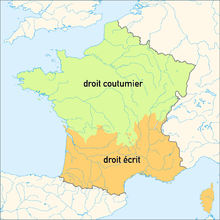Old French law
This article includes a list of generalreferences,butit lacks sufficient correspondinginline citations.(November 2019) |

Old French law,referred to inFrenchasAncien Droit,was the law of theKingdom of Franceuntil theFrench Revolution.In the north of France were thePays de coutumes('customary countries'), wherecustomary lawswere in force, while in the south were thePays de droit écrit('countries of written law'), whereRoman lawhad been paramount. Roughly speaking, the line separating the two areas was the riverLoire,fromGenevato the mouth of theCharente,although this was not a firm border between the two categories of law.[1]As worded by George Mousourakis, "in both zones, the law in force also included elements derived from royal,feudal,andcanonical sources."[2]
Pays de coutumes
[edit]This sectionis missing informationabout specific examples of customary laws, especially local.(April 2020) |
In the north existed a variety of customs "with a Frankish-Germanic character."[2]
In the tenth and eleventh centuries, as theCarolingiansgave way to theCapetians,Frankish lawbroke up into many different systems, according to the territories, some extremely small, won by princes and prelates.[3]
Thecoutumeswere asserted and enforced underfeudalismduring theMiddle Agesand in theearly modern periodby the French kings and their vassals, especially in the lands of theÎle-de-France,to the exclusion of Roman law. A number of regionalcoutumesstarting from the 13th century: e.g. theCoutumes de Beauvaisis,compiled byPhillipe de Remy.By the 16th century, theCoutume de Paris,first published in 1510, eventually extended to all of theParlement of Paris' jurisdiction and beyond in cases of any allegedlacunae in the local customs.Antoine Loyselpublished a work of 958 legal maxims developed over a period of 40 years distilling thecoutumesin hisInstitutes coutumières: Ou manuel de pluſieurs & diuerſes reigles, ſentences, & Prouerbes tant anciens que modernes du Droict Couſtumier & plus ordinaire de la Francein 1607.[4]Further development of customary law had been halted by the late 16th century.[5]
For example, Claude de Ferrière commented that "community of goods" ( "a partnership between married persons of all personal property, and of all real property acquired during the marriage state" ) prevailed "throughout all customary France, exceptNormandy,RheimsandAuvergne."[6]
Pays de droit écrit
[edit]George Mousourakis stated "after the revival of Roman law in the late eleventh and twelfth centuries and the spread of its study fromBolognatoMontpellierand other parts of France,the Roman law of Justiniancame to be accepted in southern France as the living law of the land ",[7]even though, as emphasized byErnest Glasson,"coutumesdid develop in those southern regions, and they often contradicted Roman law. "[8]"Prior to this, thepays de droit écritin the south followed pre-Justinian Roman law, based primarily on theCode of Theodosius II(A.D. 438) ",[9]as reissued in theAlarician Breviary.[10]AsAntonio Padoa-Schioppawrote,
When the monarchy was forced to take into account the reality in countries that had written laws, in order to avoid any potential subordination with respect to the[Holy Roman] Empire– of which Justinian Roman law was considered the expression – KingPhilip IV the Fairestablished in 1312, with an ordinance, that in thePays de droit écritRoman law was admitted,[clarification needed]but only as a local custom, not as imperial law.[10]
Attempts to codify
[edit]
Louis XIhad formed the idea of using throughout his realm one custom, one weight, one measure.Henry IIIannounced to theStates of Bloishis intention of resuming this design, and he caused a code of law to be prepared, andLouis XIIIfollowed the same example. But these efforts were wholly lost. In the time ofLouis XIV,under the direction of some of the celebrated jurists of his reign, the royal power of making laws for the whole realm was exercised, and some very admirable ordinances or statutes were enacted, but they only embraced a few isolated portions (or heads) of law. UnderLouis XV,and particularly through the labours ofD'Aguesseau,more royal ordinances were made; but these only remodelled detached morsels of the whole system, and the revolution in 1790 found France governed by nearly 300 systems of customary law.[11]
In the 18th century,Voltairedeclared that in travelling through France one changed the laws as often as one changed horses.[1]
When theNapoleonic Codeentered into force in 1804 allcoutumeswere abolished.[1]However, French customary law was incorporated into the substance of the code.[12]
North America
[edit]In 1664, under the royal act creating theFrench East India Company,the Custom of Paris became the only law of the land inNew France.[13]In 1866 theCivil Code of Lower Canadawas adopted inLower Canada.The majority of the Code's rules borrowed heavily from the Custom of Paris.[14]
See also
[edit]References
[edit]- ^abc"The Civil Code: an Overview".www.napoleon-series.org.
- ^abMousourakis, George (2019).Comparative Law and Legal Traditions: Historical and Contemporary Perspectives.p. 217.ISBN9783030282813.
- ^Zweigert, Konrad; Kötz, Hein (1977).An Introduction to Comparative Law: The framework.p. 70.ISBN9780720407037.
- ^Charles-Louis-Étienne Truinet(1852).Éloge d'Antoine Loysel prononcé à la séance d'ouverture de la conférence de l'ordre des avocats, le 9 décembre 1852.Paris: C. Lahure.
- ^"Legal History of France".Archived fromthe originalon 2013-09-29.Retrieved2010-05-31.
- ^ABRAHAM, Robert (1849).Some Remarks upon the French Tenure of "Franc Aleu Roturier", and on its relation to the feudal and other tenures.p. 61.
- ^Mousourakis, George (2003).The Historical and Institutional Context of Roman Law.Routledge. p. 435.ISBN9781351888417.
- ^Caswell, Jean; Sipkov, Ivan (2006).The Coutumes of France in the Library of Congress.p. 3.ISBN9781584776277.
- ^Revue générale de droit.Vol. 24. 1993. p. 524.
- ^abPadoa-Schioppa, Antonio (2017).A History of Law in Europe: From the Early Middle Ages to the Twentieth Century.Cambridge University Press. p. 185.ISBN9781107180697.
- ^The Law Magazine and Law Review.Vol. 1. 1856. p. 5.
- ^Stigall, Dan E. (2017).The Santillana Codes.p. 76.ISBN9781498561761.
- ^"Coutume de Paris".The Canadian Encyclopedia.
- ^Roderick A. Macdonald."Civil Code".The Canadian Encyclopedia.
